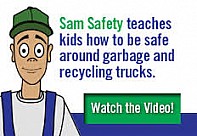January 10, 2017
Today’s article continues from Part 1 of Safety – It’s Everyone’s Responsibility.
Workers in many areas of materials management face daily hazards, in landfills, materials recycling facilities, transfer stations, and compost operations; and of course the men and women on the roads, collecting waste and recycling. Employers are responsible for providing safety training, and should provide daily reminders to their employees as well, to help lessen the incidence accidents and injuries. Employers must actively enforce safety requirements, through positive recognition for employees practicing safety and correcting employee activities that are unsafe.
Two of the most common injuries for solid waste and recycling workers relate to lifting and falling. At NERC’s Fall 2016 Conference, David Biderman, SWANA’s Executive Director/CEO, recommended training in proper lifting for new hires, and refresher courses on an annual basis for all employees. Falls can be attributed to three primary causes: unsafe footwear, rushing, and failing to adjust for bad weather. Ensuring that employees have the correct footwear, and regular training and reminders, can help employees focus on safe operations.
Biderman also points out that in the U.S., “Successful employers are engaging employees and getting them to change their unsafe behaviors.”
Another presenter at NERC’s Fall Conference was Bob Cappadona, Vice President of Casella Recycling. In his presentation, Safety from a MRF Perspective, Mr. Cappadona provided numerous invaluable observations about creating a safe work environment. Safety needs to start with senior leaders committing time and funding, he stated; employers must ensure active participation at all levels in order to gain buy-in and cooperation. “Consistency in message and action,” he said, is imperative for a successful safety program.
Mr. Cappadona aptly described the “Evolution of Effective Safety”:
- Beginning - Manager driven and owned
- Developing - Management initiated and quota driven
- Performing - Management driven with increasing employee involvement/ feedback
- High Performing - Employee-led with strong management support
- Excelling - Safety partnership of management and employees, with comprehensive coverage of the most likely safety challenges
Employees are responsible for wearing Personal Protective Equipment (PPE) at all times while on the job, practicing the safety training they’ve received, and being mindful of the hazards they face while at work.
What can the rest of us do to help improve safety in the materials management industry?
A 2015 survey found that a majority of Americans regularly encounter collection vehicles on the road, but only a third slow down while nearing them. More alarming is the finding that nearly 40 percent stated they were actually tempted to “speed around them.”
 The National Waste & Recycling Association’s Slow Down to Get Around is a national safety campaign focused on reminding motorists to drive more carefully when near waste and recycling collection vehicles. The National Institute for Occupational Safety and Health has endorsed the campaign, and partnered with NWRA to develop materials for in public awareness campaigns, including PSAs and a flier which can be posted on municipal and hauler websites.
The National Waste & Recycling Association’s Slow Down to Get Around is a national safety campaign focused on reminding motorists to drive more carefully when near waste and recycling collection vehicles. The National Institute for Occupational Safety and Health has endorsed the campaign, and partnered with NWRA to develop materials for in public awareness campaigns, including PSAs and a flier which can be posted on municipal and hauler websites.
An important strategy in NWRA’s safety campaign is lobbying states to pass legislation promoting Slow Down to Get Around. Currently, only eight states have adopted such laws: Alabama, Florida, Georgia, Indiana, Michigan, New York, Oklahoma, West Virginia, and Wisconsin.
The laws follow two basic models: higher penalties for drivers hitting waste and recycling workers; and requiring drivers to slow down (for example, to 10 mph) or move over a lane when passing collection vehicles.
 Some waste disposal companies have campaigns to teach kids safety around collection vehicles, including Advanced Disposal’s Sam Safety: Showing Kids How To Be Safe Around Garbage Trucks. Such efforts not only keep children safer, but also serve to remind employees of the need for caution around collection vehicles.
Some waste disposal companies have campaigns to teach kids safety around collection vehicles, including Advanced Disposal’s Sam Safety: Showing Kids How To Be Safe Around Garbage Trucks. Such efforts not only keep children safer, but also serve to remind employees of the need for caution around collection vehicles.
Promoting adoption of NWRA’s Slow Down to Get Around model legislation in the states that haven’t yet adopted such laws would be one positive step toward creating a safer work environment for all workers in our profession. Government agencies and organizations engaged in material management could do their part as well, by posting and promoting NWRA’s informational PSAs and flier.
Part 3 of Safety – It’s Everyone’s Responsibility will explore safety at solid waste and recycling operations.
By Athena Lee Bradley


Comments (0)
Add a Comment